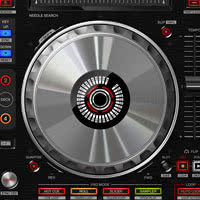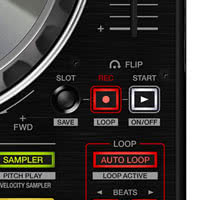Der DDJ-SX3 ist der neueste Vierkanal-Controller von Pioneer für Serato DJ Pro. Er ist mehr Evolution als Revolution, und es bietet noch mehr Leistung im DDJ-SX-Formfaktor mit drei Mikrofoneingängen, zwei USB-Anschlüssen, eigenständigem Sound Color FX Effekten und Tastensteuerung. Das Einzige, was wir auf ihm sehen wollten, waren die Displays für die Jogwheels. Trotzdem ist es der ultimative Pioneer DJ-Controller mit vier Kanälen für das aktuelle Serato DJ Pro-Feature-Set.
Erste Eindrücke / Einrichtung
 Sechs Jahre ist es her, dass der ursprüngliche DDJ-SX-Controller das digitale DJing veränderte. Er galt damals als massiv und riesig - kleinere Controller wie die Vestax VCI-300 und die Traktor Kontrol S4 beherrschten damals das Spiel, als Portabilität und Form an erster Stelle standen. Diese Kompromisse (wie auch die allgemeine Neuheit des digitalen DJing) führten dazu, dass Controller als "Spielzeug" bezeichnet wurden.
Sechs Jahre ist es her, dass der ursprüngliche DDJ-SX-Controller das digitale DJing veränderte. Er galt damals als massiv und riesig - kleinere Controller wie die Vestax VCI-300 und die Traktor Kontrol S4 beherrschten damals das Spiel, als Portabilität und Form an erster Stelle standen. Diese Kompromisse (wie auch die allgemeine Neuheit des digitalen DJing) führten dazu, dass Controller als "Spielzeug" bezeichnet wurden.
Der DDJ-SX hat das DJ-Controller-Paradigma verändert, indem er groß, voll ausgestattet und professionell war. Club- und Profi-DJs hatten jetzt einiges an Equipment, das sie zu Auftritten mitnehmen konnten, und mobile DJs hatten eine zuverlässige Einheit, die die Ein- und Ausgänge enthielt, die sie für die Durchführung von Shows brauchten.
Schneller Vorlauf bis heute: DJ-Controller sind leistungsfähiger als je zuvor, sogar in DJ-Setups zu finden, und sie sind auch viel größer (siehe DDJ-RZX und Numark NS7III). Dies ist die Landschaft, in der Pioneer DJ seinen neuesten Controller veröffentlicht hat: Der DDJ-SX3 ist die dritte Iteration des DDJ-SX, und er behält das meiste von dem, was DJs an ihm lieben, während sie ein paar Neuerungen hineinwerfen.
Der Controller hat jetzt drei Mikrofoneingänge und einen eingebauten Sound Color FX, den man bei Pioneer DJ-Mixern oder DJ-Flaggschiff-Controllern wie dem DDJ-SZ2 findet. Die Mixer-Sektion erhält ein neues, graues Finish und der Sampler-Lautstärkeregler ist jetzt ein Regler statt ein Fader. Der Crossfader ist nicht mehr austauschbar.
Auf der Rückseite befinden sich XLR- und Chinch-Master-Ausgänge, 6.3″ Booth-Ausgänge, vier Paar Chinch-Line-Eingänge, von denen zwei umschaltbar sind, ein Combo-TRS-Mikrofoneingang, ein XLR-Mikrofoneingang, zwei USB-Buchsen zum Anschluss von bis zu zwei Laptops, eine Netzbuchse und ein Netzschalter.
Auf der Vorderseite des Geräts befinden sich 6.3 und 3.5 mm Kopfhörerbuchsen, ein Kopfhörer-Lautstärkeregler, ein Kopfhörer-Mix-Regler, ein Crossfader-Kurvenregler und ein 6.3 Klinken-Mikrofoneingang mit Pegelregler und Ein-/Ausschalter.
Der DDJ-SX3 kommt mit Serato DJ Pro und einer Reihe von Erweiterungen: Serato Pitch 'n Time DJ und Serato Flip sind enthalten. Es ist auch Serato DVS ready, d.h. man kann ihn mit Turntables und Timecode Vinyl verwenden, wenn man das Serato DVS Upgrade erwirbt.
Drei Mikrofoneingänge
 Die größte Neuerung des DDJ-SX3 sind seine Mikrofoneingänge. Pioneer DJ hat hier insgesamt drei Mikrofonbuchsen hinzugefügt: einen Combo-TRS-Eingang und einen XLR-Eingang auf der Rückseite des Geräts sowie eine 6.3 Klinken-Buchse für die Vorderseite. Die ersten beiden Mikrofoneingänge können auf die Kanäle 3 und 4 des Mischpults geroutet werden, so dass man den EQ anpassen und Sound Color FX auf sie anwenden kann.
Die größte Neuerung des DDJ-SX3 sind seine Mikrofoneingänge. Pioneer DJ hat hier insgesamt drei Mikrofonbuchsen hinzugefügt: einen Combo-TRS-Eingang und einen XLR-Eingang auf der Rückseite des Geräts sowie eine 6.3 Klinken-Buchse für die Vorderseite. Die ersten beiden Mikrofoneingänge können auf die Kanäle 3 und 4 des Mischpults geroutet werden, so dass man den EQ anpassen und Sound Color FX auf sie anwenden kann.
Es ist unwahrscheinlich, dass man alle drei Mikrofoneingänge gleichzeitig nutzen wird, obwohl mobile DJs die Flexibilität genießen werden, die sie bieten.
Sound Color FX Effekte
Im Gerät sind Sound Color FX fest eingebaut. Diese sind in der Regel auf Pioneer DJM-Mixern und teureren DDJ-Controllern zu finden, aber vier von ihnen kommen schließlich in der DDJ-SX-Serie zum Einsatz: Echo, Jet, Noise und Filter. Sie funktionieren und klingen wie erwartet und haben den zusätzlichen Vorteil, dass sie eigenständig verwendet werden können, so dass Sie jedes beliebige Audiosignal über die vier Kanäle erzeugen können.
Mixer
Der DDJ-SX3 ist mit einem eigenständigen Vierkanal-Mixer ausgestattet, so dass man ihn auch ohne angeschlossenen Laptop verwenden kann, um Audiosignale (ob Line-, Phono- oder Mikrofonsignale) zu routen. Der Sound Color FX funktioniert auch eigenständig.
Jeder der vier Mixerkanäle verfügt nun über eine Eingangsumschaltmatrix, über die man auf einen der beiden USB-Ports (für DJ-Umschaltungen / B2B-Sets), Phono/Line-Eingänge für Kanal 1 und 2 und Mikrofoneingänge 1 und 2 für Kanal 3 und 4 zugreifen kann.
Layout-Optimierungen
 Während der DDJ-SX3 fast identisch mit dem DDJ-SX2 Vorgänger aussieht, gibt es ein paar feine Unterschiede: Sampler Volume ist jetzt ein Knopf anstelle eines Lautstärkereglers (vermutlich um Platz für den Sound Color FX zu schaffen). Der Kopfhörer-Mix-Regler wurde neben den Kopfhörer-Lautstärke- und Kopfhörer-Ausgangsbuchsen an der Vorderseite des Geräts angebracht.
Während der DDJ-SX3 fast identisch mit dem DDJ-SX2 Vorgänger aussieht, gibt es ein paar feine Unterschiede: Sampler Volume ist jetzt ein Knopf anstelle eines Lautstärkereglers (vermutlich um Platz für den Sound Color FX zu schaffen). Der Kopfhörer-Mix-Regler wurde neben den Kopfhörer-Lautstärke- und Kopfhörer-Ausgangsbuchsen an der Vorderseite des Geräts angebracht.
Eine weitere Änderung sind die Key-Shifting-Bedienelemente, die die Grid Adjust und Slide-Buttons auf beiden Decks ersetzt haben. Das bedeutet, dass Pioneer DJ (und Serato im weiteren Sinne) den Schwerpunkt auf leistungsbasiertes harmonisches Mischen legen will, im Gegensatz zu Grid-Tweaking, das immer noch über die Tastatur und Maus des Computers möglich ist. Dies zeigt sich auch in der Möglichkeit, auf Pitch Play in den Performance-Pads zuzugreifen, die zum Zeitpunkt der Einführung des DDJ-SX2 noch nicht verfügbar war.
Fazit
 Wer auf der Suche nach einem neuen Vierkanal-Controller ist, der einem die besten und neuesten Funktionen von Serato DJ Pro zur Verfügung stellt und gleichzeitig die Ein- und Ausgangskonnektivität bietet, die für die anspruchsvollsten Auftritte und professionellen Auftritte erforderlich sind, dann ist der DDJ-SX3 genau das Richtige.
Wer auf der Suche nach einem neuen Vierkanal-Controller ist, der einem die besten und neuesten Funktionen von Serato DJ Pro zur Verfügung stellt und gleichzeitig die Ein- und Ausgangskonnektivität bietet, die für die anspruchsvollsten Auftritte und professionellen Auftritte erforderlich sind, dann ist der DDJ-SX3 genau das Richtige.
Wer bereits ein DDJ-SX2-Besitzer ist, wird hier nicht viel Neues vorfinden, um auf den neuen Controller zu wechseln, obwohl Besitzer von älteren oder weniger leistungsfähigen Pioneer DJ-Controllern wie dem DDJ-SB und dem DDJ-SR sich freuen werden, dass ein fantastischer Controller in der DDJ-SX3 noch besser geworden ist und somit eine Wechseloption darstellt.
Es hätte aber nicht geschadet, die Jogwheels auf dem DDJ-SX3 zu aktualisieren und ihm wenigstens On-Jog Display wie z.B. beim DDJ-1000 zu spendieren.
Trotzdem bleibt der DDJ-SX3 ein hochwertiger Controller, der genug Möglichkeiten bietet, um Serato DJ Pro Anwender zu begeistern. Während einige den Mangel an spielerischer Innovation beklagen mögen, ist der DDJ-SX3 einfach Pioneer DJ, der ein gut ausgearbeitetes Feature-Set poliert und auf nahezu Perfektion einstellt. Sehr empfehlenswert für alle, die einen neuen Serato DJ Pro Controller suchen.





